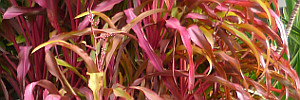|
Information about plants & gardens for Brisbane & Qld |
|
Cordylines
Cordyline species and cultivars
Family: Asparagaceae (previously listed in Liliaceae, Lomandraceae or Agavaceae)
Cordylines are colourful foliage plants which have become very popular in recent years, partly because the range of varieties available in the marketlace has expanded, and partly because they are so complimentary to modern landscaping styles. Depending on the variety you choose, they can deployed in lush tropical gardens or as tough potted accents for a contemporary patio.
Cordyline fruticosa
(synonyms: Coryline terminalis, Dracaena terminalis)
This group of cordylines will be the most familiar to the average Queensland gardener, being very popular in lush "Balinese" or resort-style tropical gardens. Many varieties in a huge range of foliage colours and patterns.
Most cordylines in this group prefer some shade. Some more sun-tolerant types include 'Roosters Tail', 'Negra', 'Peter Buck', 'Pink Diamond'. For others, check the label.
Most fruticosa varieties prefer light shade. If leaves look burnt and tatty it may be that the variety can't cope with the amount of sun being received. In that case, the plant could be moved.
Multiple-planting several of the same variety will have more of an impact than individual specimens sprinkled among other plants. They can also be cut back to encourage branching when they get too lanky.
Older specimens will develop long stalks with tufts of leaves at the top. Sometimes this can give an interesting jungle effect, but eventually the beauty of the foliage will be hard to see. These stalks can be cut back to short stumps from which new shoots should appear. This will not only eliminate the spindly trunks but make the plant branch and look fuller. A little fertiliser and water will be helpful in this regard.
Cut pieces needn't be wasted as they are easy to root in potting mix in a shady place, giving lots of new plants for free. Pieces of stem root easily. Besides providing lots of free plants for massed effects, you can cheaply expand your collection by raiding friends' gardens.
Key features:
• easy to grow and reasonably drought tolerant
• long-lasting colour (mass for best effect)
• variety of sizes and colours to choose from
• great for creating Balinese or other tropical-style style gardens
• cut back if the canes become leggy
• suitable for containers
• suitable for planting under trees
• try dark colours in sunnier positions
Cordylines in the Landscape
This is a growing gallery of images to give you ideas about suitable placement and plant combinations. There are so many varieties it's no possible to identify them all on sight, but there are some that are produced in big numbers commercially and widely planted. An attempt will be made to name these your your own identification purposes, if possible. Click for larger images.
Assorted cultivars
Probably cultivar 'Rooster Tail'
Cordyline 'Negra'. Very popular with landscapers and sun tolerant.
Cordyline 'Pink Diamond'. Also widely used in landscaping. Often planted in sun but suffers for it. Would be better in light shade.
Cordyline 'Miss Andrea'
Unknown cultivar, possibly 'Fire Fountain', also known as 'Firestorm'.
Cordyline australis and hybrids
C. australis or Cabbage Tree, is native to New Zealand, and is also quite popular in cultivation. Some commercial cultivars are hybrids with other species such as C. banksii and C. pumilo. The elongated foliage gives a dramatic spikey look which is popular in modern, minimalistic garden styles, particularly as accents in pots.
Tend to be tough and drought tolerant, for sunny positions.
Selected forms include foliage with purple, red and yellow tones. Some commercial cultivars have been selected for a low, clumping growth habit especially for pots and accent planting.
Australian Native Cordylines
There are several Australian native Cordyline species. These are less spectacular than the commonly cultivated types, althought displays of berries can be quite attractive. They are certainly a must for an Australian native rainforest-style garden.
The plants in the photographs below have been tentatively identified based on the most readily available species and their general appearance.
Probably Cordyline petiolaris
Probably Cordyline manners-suttoniae
Probably Cordyline stricta
Looking for more information about growing cordylines or other plants in Queensland? Due to the demise of online advertising and the rise of content appropriation (particularly by artificial intelligence), most of the in-depth information that might otherwise have appeared on these pages is now being directed towards the email publication (mini-magazine) Get Results Gardening. If you live in Australia, ask for a free trial. Go to calyx.com.au/getresultsgardening.html for more information.
|
© Calyx Horticultural Services ABN 38 518 961 623
|

